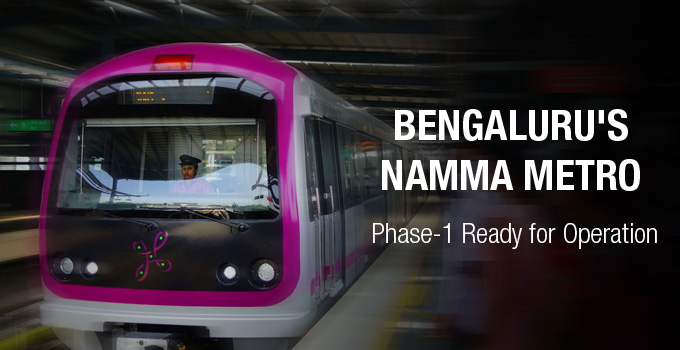After about a decade since work began on Phase I of the Bengaluru Metro, the people of India’s technology hub are set to enjoy their first metro ride on Sunday, 18 June, 2017. The 42 kilometre long Namma Metro is set to be inaugurated by the President of India, Pranab Mukherjee, after a short dedication ceremony. Several major delays and cost escalations had haunted the progress of its implementation but now that it is ready for use by the public, the Namma Metro is likely to come as a blessing for Bengaluru residents. The city is one of the most populous in India (2017 population estimate – 12.3 million) and is riddled with traffic and infrastructure woes.
Bringing Much Needed Relief
The Phase I of Namma Metro is made up of two different lines – one running 18 kilometres from east to west and another covering 24 kilometres covering north to south. Work on Phase I of Namma Metro (the Metro of Bengaluru city) was initiated in 2005 and has now reached completion but not before several deadlines were missed. This phase was set to be finally completed in March 2015. Such delays, however, do not mean that metro services were completely unavailable in the city. Starting from 2011, metro trains have been available over partial stretches. Sunday’s inauguration shall, however, represent the completion of the entire phase and integration of these stretches.
There are over 40 Metro stations including seven underground stations that are likely to connect the city. Bengaluru is infamous for its traffic holdups and for the long duration that in-city travel takes. With the introduction of metro the maximum time that on is likely to take to go from north to south or from east to west is about 44 minutes.
A Look At The Costs And Damages
The initial cost estimate for the construction of Phase I of the Bengaluru Metro was INR 6,375 crore. This later escalated to INR 13,854 crore as additional stretches were added and the project ran into delays. Defending the costs, however, Metro authorities have claimed that the time value of money justifies the increased costs. Besides, the convenience and savings that the Metro brings the commuters will pay for itself over the years.
The main reason for the delay in the implementation of Namma Metro Phase I seems to be the geographic challenges. Bengaluru is located on the Deccan Plateau and the hard rocky surface made drilling tunnels a great challenge. The burgeoning city also made it impossible to work on the project throughout the day without causing major inconvenience to the people. There have been places where work was undertaken only at night.
Another major concern that has surfaced is the great environmental damage wrought by the implementation of the Bengaluru Metro. It looks like an environmental damage assessment was not undertaken prior to its implementation and vast corridors of trees have been razed to facilitate its construction. Given the high levels of pollution that Bengaluru is already facing, this certainly seems to be a disconcerting revelation.
City Prepares For President’s Arrival
Despite the concerns we must acknowledge the host of benefits that a robust public transport such as the Metro is likely to bring to the people of Bengaluru. Over 5 lakh people are likely to save time, cost, and fuel by using the Metro on a daily basis. The city is now ready to welcome the President of India and various traffic restrictions and diversions have been created (only for Sunday). At the same time there are gladdening news reports that suggest that work on Phase II of the Bengaluru is already underway.
Read More





